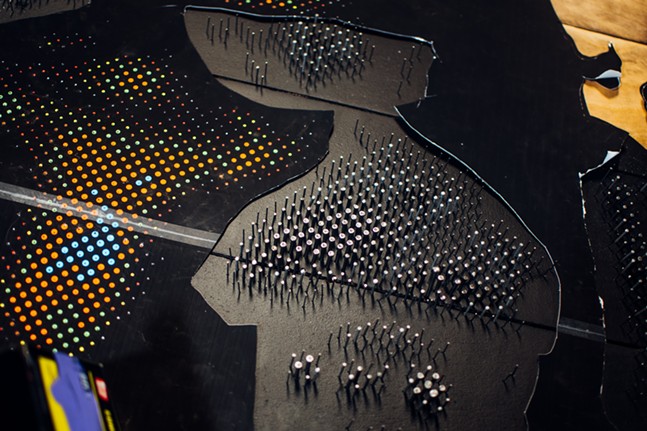If your knowledge of Alexis Peskine was based solely on a glance, it would still tell you quite an accurate bit. He’s extremely tall at 6’5” — to assume he’s played competitive basketball would be correct. His eclectic style is laden with clues about his global influences: the patterns on his clothes and his colorful, beaded jewelry scream Motherland. His hands are crazy large, but he utilizes them with quiet grace. He's great to look at. But it’s a missed opportunity to be in Peskine’s presence and not engage him in conversation; that’s where his intellectualism, worldliness, love for the African diaspora, and sincere humility about his talent takes precedence.
Since April 10, Peskine has been in residency at Carnegie Mellon University on invitation from professor and filmmaker Dr. Mame-Fatou Niang, and will be showcasing his newest work at The Irma Freeman Center for Imagination on Wed., May 8.
“The Black experience is the human experience. It’s an extreme human experience — extreme challenges and harshness and the joy and creativity that comes out of it.”
Born in Paris in 1979 to an Afro-Brazilian mother and a Franco-Russian father, Peskine says his artwork is "about the Black experience on a global level." His work, which includes photography, film, and mixed media portraiture, has exhibited in 15 countries. His signature and most recognizable pieces are large-scale portraits of people with African lineage. They're made of earth and coffee-stained wood pierced by hundreds, sometimes thousands, of nails brushed with moon gold leaf. The works appear as pointillism when photographed straight-on, but when viewed at an angle, they become sculptural and almost interactive. They demand perspective from the viewer as much as they lend perspective from the artist and the diaspora he champions.
“I’m very bothered by social injustices. I'm active; I got my ear tapped to what’s happening to us worldwide. Wherever I go I’m trying to find out why the racial dynamics or the identity dynamics [are what they are].”
“Mame-Fatou and I bond a lot on social issues for Black France and ideas on the world in general,” he says from the Uptown artist studio he’s been using during his stay in Pittsburgh. “CMU is very interdisciplinary. She brought me in for the Department of Modern Languages to conduct a workshop and work with students to create a piece.” The piece he's been working on with the students is the newest addition to his wood and nails series.
During our interview, I was quickly roped into handing him nails from color-coded boxes as he hammered them into the stained wood. It's a deliberate, guided process that follows template, but I lost my place at least twice because he is fast. As we talk, he oscillates between brushing off the excess gold leaf that shimmers across each nail head with a brush and blowing glitter fragments away from the black silhouette in which they're embedded.
“A nail — you overlook it, it’s a banal material. But without the nail everything falls apart. It’s invisible, but it’s there.”
There are metaphors for every choice Peskine makes. He credits Professor Sorrels Adewale, his Mixed Media Art professor at Howard University, with encouraging intentionality behind his use of materials. After taking a printmaking class, he began experimenting with alternate ways to use halftones. He chose nails as an homage to the Nkisi N'Kondi power figures of the Congo. For those that own them, these figures serve as protection and a source of power, which Peskine states Black people have been stripped of worldwide.
Driving the nails into the wood is an act that mirrors the perceived aggression of the Black body and further conjure allusions to bullets puncturing skin. "But," he adds, "nails are also used to build things. This is the idea of construction and deconstruction. We have built — our ancestors, enslaved Africans — the strongest economies and nations in the world."
“I talk about the Black experience through the dark skinned Black body in my work. And also, aesthetically, with the nails reflecting the light, the contrast actually works better. It’s more beautiful. It’s my artistic affirmative action.”
Peskine is the color of cedarwood. He isn't ethnically ambiguous at all — he's a Black man and looks it. But his multiracial ancestry and his skin tone lends a measure of privilege in a world that is still heavily influenced by colorism. Thus, he is intentional about the people he chooses as his subjects. These mixed media pieces, as well as his photography and films, all feature darker skinned Black people. "The darker you are, the less likely you are to be seen as beautiful," he says. "There’s not one place in the world where being darker gives you more power. I personally see extreme beauty in the dark skinned body."
“Gentrification is very aggressive here.”
He considers travel to be the most important hallmark of his practice. Peskine agrees Pittsburgh’s artist community is underrated in its vibrancy, naming Thaddeus Mosley and Vanessa German as a couple of his favorite local artists. He also had an opportunity to meet activist Leon Ford and finds him inspiring. He loves learning about the history of the Hill District and has become better versed on the rampant gentrification in East Liberty. And in a perhaps unbeknownst nod to our region's nickname — "Paris of Appalachia”—he also sees similarities between Pittsburgh and his hometown. Namely that it's a big city that "feels like a small town" and, like Paris, Pittsburgh lacks the nurturing necessary to retain the talent that's born and/or bred here. He says there are many French-born Black artists who had to move to America or elsewhere to find success: "Nul n'est prophète en son pays (No one is a prophet in his own land)."















